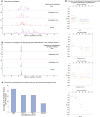Use of an informed search space maximizes confidence of site-specific assignment of glycoprotein glycosylation
- PMID: 27734143
- PMCID: PMC5283608
- DOI: 10.1007/s00216-016-9970-5
Use of an informed search space maximizes confidence of site-specific assignment of glycoprotein glycosylation
Abstract
In order to interpret glycopeptide tandem mass spectra, it is necessary to estimate the theoretical glycan compositions and peptide sequences, known as the search space. The simplest way to do this is to build a naïve search space from sets of glycan compositions from public databases and to assume that the target glycoprotein is pure. Often, however, purified glycoproteins contain co-purified glycoprotein contaminants that have the potential to confound assignment of tandem mass spectra based on naïve assumptions. In addition, there is increasing need to characterize glycopeptides from complex biological mixtures. Fortunately, liquid chromatography-mass spectrometry (LC-MS) methods for glycomics and proteomics are now mature and accessible. We demonstrate the value of using an informed search space built from measured glycomes and proteomes to define the search space for interpretation of glycoproteomics data. We show this using α-1-acid glycoprotein (AGP) mixed into a set of increasingly complex matrices. As the mixture complexity increases, the naïve search space balloons and the ability to assign glycopeptides with acceptable confidence diminishes. In addition, it is not possible to identify glycopeptides not foreseen as part of the naïve search space. A search space built from released glycan glycomics and proteomics data is smaller than its naïve counterpart while including the full range of proteins detected in the mixture. This maximizes the ability to assign glycopeptide tandem mass spectra with confidence. As the mixture complexity increases, the number of tandem mass spectra per glycopeptide precursor ion decreases, resulting in lower overall scores and reduced depth of coverage for the target glycoprotein. We suggest use of α-1-acid glycoprotein as a standard to gauge effectiveness of analytical methods and bioinformatics search parameters for glycoproteomics studies. Graphical Abstract Assignment of site specific glycosylation from LC-tandemMS data.
Keywords: Alpha-1-acid glycoprotein; Glycoinformatics; Glycomics; Glycoproteomics; Glycosylation; Integrated-omics; Mass spectrometry.
Conflict of interest statement
Conflict of interests The authors have no conflicts of interest.
Figures





References
-
- Leymarie N, Griffin PJ, Jonscher K, Kolarich D, Orlando R, McComb M, Zaia J, Aguilan J, Alley WR, Altmann F, Ball LE, Basumallick L, Bazemore-Walker CR, Behnken H, Blank MA, Brown KJ, Bunz S-C, Cairo CW, Cipollo JF, Daneshfar R, Desaire H, Drake RR, Go EP, Goldman R, Gruber C, Halim A, Hathout Y, Hensbergen PJ, Horn DM, Hurum D, Jabs W, Larson G, Ly M, Mann BF, Marx K, Mechref Y, Meyer B, Möginger U, Neusüss C, Nilsson J, Novotny MV, Nyalwidhe JO, Packer NH, Pompach P, Reiz B, Resemann A, Rohrer JS, Ruthenbeck A, Sanda M, Schulz JM, Schweiger-Hufnagel U, Sihlbom C, Song E, Staples GO, Suckau D, Tang H, Thaysen-Andersen M, Viner RI, An Y, Valmu L, Wada Y, Watson M, Windwarder M, Whittal R, Wuhrer M, Zhu Y, Zou C. Interlaboratory study on differential analysis of protein glycosylation by mass spectrometry: the ABRF glycoprotein research multi-institutional study 2012. Mol Cell Proteomics. 2013 doi: 10.1074/mcp.M113.03064. - DOI - PMC - PubMed
-
- Desaire H, Hua D. When can glycopeptides be assigned based solely on high-resolution mass spectrometry data? Int J Mass Spectrom. 2009;287:21–6. doi: 10.1016/j.ijms.2008.12.001. - DOI
MeSH terms
Substances
Grants and funding
LinkOut - more resources
Full Text Sources
Other Literature Sources
Research Materials

